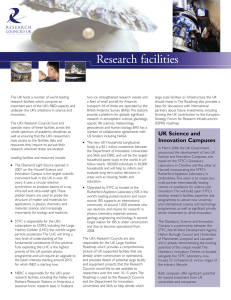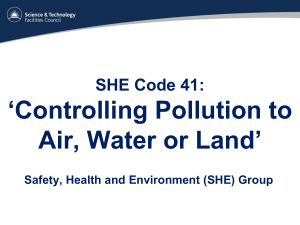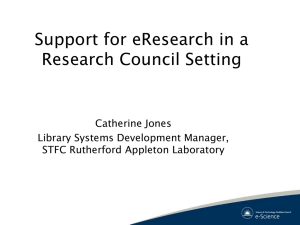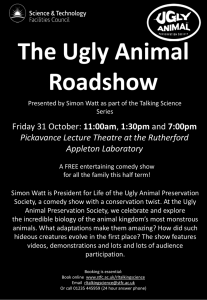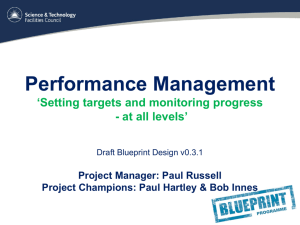STFC Corporate PowerPoint Presentation
advertisement
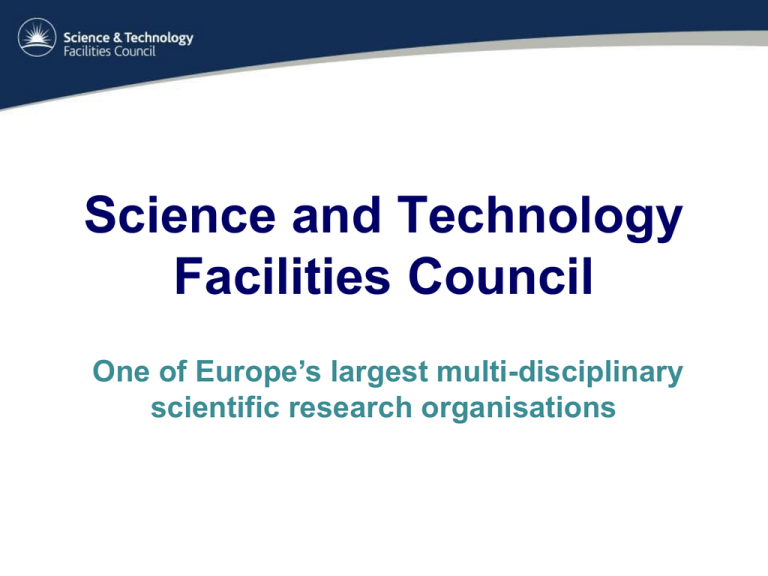
Science and Technology Facilities Council One of Europe’s largest multi-disciplinary scientific research organisations UK Science Governance HM Government (and HM Treasury) RCUK Executive Group STFC Role We enable a broad range of scientists to do world class and world-leading research, tackling some of the most fundamental scientific questions, both curiosity driven and application led We do this by: o Funding university researchers o Providing access to UK world class facilities o Providing access to world class overseas facilities This generates an asset base which we then promote and exploit to stimulate innovation and growth in the economy UK Astronomy Technology Centre Edinburgh, Scotland Polaris House Swindon, Wiltshire Daresbury Laboratory Daresbury Science and Innovation Campus Warrington, Cheshire Rutherford Appleton Laboratory Harwell Science and Innovation Campus Didcot, Oxfordshire Chilbolton Observatory Stockbridge, Hampshire Joint Astronomy Centre Hawaii Isaac Newton Group of Telescopes La Palma STFC Funding Three budget strands: • International Subscriptions – set by BIS • Facilities – agreed by other RCs • Core programme – STFC priorities International Subscriptions o CERN (14%) o European Southern Observatory (20%) o European Synchrotron Radiation Facility (15%) o Institute Laue-Langevin (33%) o Gemini Observatory (20%) STFC Facilities – driving scientific research Neutron Source - ISIS Providing powerful insights into key areas of energy, biomedical research, climate, environment and security High Power Lasers Providing applications on bioscience and nanotechnology and demonstrating laser driven fusion as a future source of sustainable, clean energy Light Source - DIAMOND Providing new breakthroughs in medicine, environmental and materials science, engineering, electronics and cultural heritage STFC’s Core Science Programme Understanding our Universe Particle Physics / Particle Astrophysics o Revealing the structure and forces of nature Large Hadron Collider, CERN o Advanced LIGO will observe and study Gravitational Waves, opening a new window on the universe Ground based Astronomy o o o o European Southern Observatory, Chile Very Large Telescope Atacama Large Millimetre Array European Extremely Large Telescope STFC’s Core Science Programme Understanding our Universe Space based Astronomy o UK Space Agency manages missions o European Space Agency and bilaterals – NASA, JAXA, etc o Missions: Herschel/Planck/GAIA/James Webb Space Telescope. o STFC RAL Space Technology Department o STFC funded science exploitation Nuclear Physics o Facility for Anti-proton and Ion Research, Germany o Nuclear Skills for - medicine, energy and environmental applications Academic Partners STFC fund university research projects and postgraduate training awards in astronomy, particle physics, space science and nuclear physics o Funding over 1,700 academics, technicians, research associates, engineers and technicians in UK universities o STFC also provide universities with the opportunity to apply for contracts with major international science facilities Technology to underpin science Developing and delivering innovative technologies in STFC laboratories and in collaboration with University groups Key Technology Strengths o o o o o o o Accelerator technologies Instrumentation Detectors and Sensors Data Acquisition and Processing Systems Microelectronics design Micro/nano technology High Performance Computing o Engineering technology centres based at Harwell and Daresbury Science and Innovation Campuses o System Integration Delivering Impact STFC’s vision is to extract maximum impact and benefit from its research base in order to: o o o o enrich society develop new skills drive the economy improve the lives of citizens Impact through inspiration and innovation www.stfc.ac.uk STFC Innovation strategy • World class Science and Facilities leading to Innovation and Skills • Strong technology base for R&D • Exploit in multiple applications • Futures – develop links to Grand Challenges • Campuses and Centres to stimulate exchange • R&D – eg RAL Space and NERC for Earth Obs • Contract work – eg ESO receivers for ALMA STFC Science and Innovation Campuses Harwell and Daresbury o Unique platform for Public/ Private Collaboration Academia/ Local Authorities/ Business o Multi-disciplinary o Providing Incubator space for new Businesses, and Specialist Research Institutes, e.g. ESA Centre Delivering Science/ Technology/ Innovation/ Commercialisation across a wide range of disciplines and sectors Science and Technology Centres Deliver a new level of engagement between Academic and Industrial Researchers o International Space Innovation Centre (ISIC) Climate change, Earth observation, Mission security o International Centre of Excellence for Computational Science Energy, Life Sciences, Environment, Materials Science o Innovations Technology Access Centre Providing laboratory space and analytical services to SMEs o Centre for Advanced Laser Technology Advanced Technologies for fast and high power lasers International Space Innovation Centre • A new environment where government, universities and industry can work together to better exploit scientific opportunities and create new technologies and IP that exploits UK, European and Global Space Programmes • ISIC project will focus on three key areas: – Climate change – Security of space systems – Earth observation data • ISIC building complex will house: – Research – agencies, academics, and commercial – Incubation of new businesses – Open Innovation and Commercialisation infrastructure Research Complex at Harwell (RCaH) • RCaH is a new, multidisciplinary laboratory that provides facilities for researchers to undertake new and cutting edge scientific research in both life and physical sciences and the interface between them. • Located on the Rutherford Appleton Laboratory (RAL) site on the Harwell Science and Innovation Campus • Adjacent to the Diamond Synchrotron Radiation (SR) source and close to other leading facilities on the campus: the ISIS neutron source, Central Laser Facility, Membrane Protein Laboratory, MRC Mammalian Genetics Unit and Mary Lyon Centre, and a Biological Solid State NMR Facility. • It is open to research teams from UK universities and the facilities. The MRC is leading the project on behalf of RCUK, in partnership with BBSRC, EPSRC, NERC, STFC and Diamond. Examples of Innovation • Bio-imaging with BBSRC • DL Innovation Centre and ITAC • Hydrogen storage materials on ISIS • ISIC and other Centres STFC science inspires Through the wonders and inspiration of its science STFC is securing the future research capability of the nation o Science inspires youngsters and school pupils to pursue further education in STEM subjects Impact through Innovation Impact through Innovation Proteins for better health Access to the European Synchrotron Radiation Facility (ESRF), through the UK’s STFC subscription, has given UK scientists the opportunity to make an important development that will help the design of new drugs o Using exceptionally small beams of X-rays the structure of G protein-coupled receptors has been determined o These findings will enable scientists to target drugs more effectively and also discover new drugs for the treatment of other diseases Mapping the brain with light Each year 10,000 people in the UK are diagnosed with Parkinson’s disease o There is currently no cure but the Diamond Light Source, the UK’s synchrotron, is helping scientists better understand the brain’s chemistry which could help early diagnosis and the development of new treatments o Early diagnosis is key to control chemical changes that cause significant cell death o This will result in more effective treatment and helping to maintain a better quality of life www.diamond.ac.uk “The atomic nucleus is responsible for more than 99.9% of the mass of all the matter we can see… 100 years after the experimental verification of The nucleus and we are still uncovering its mysteries.” Professor Paddy Regan, University of Surrey o Exotic nuclei often only exist for fractions of a second before they decay a gamma-ray spectrometer, designed and built at STFC Daresbury Laboratory, is enabling scientists to study their existence and internal structure www.stfc.ac.uk A new vision for new times Impact through inspiration and innovation


